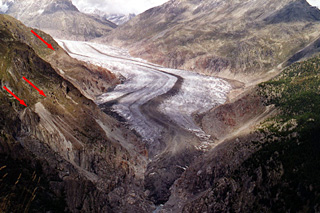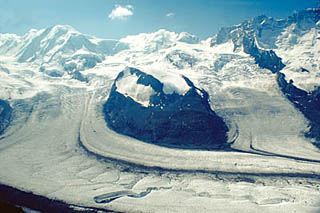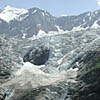 |
|
|
|
|
|
|
The reconstruction of Holocene glacier fluctuations helps to detect the range of natural climate fluctuations. Therefore different methods for recontructin Holocene glacier fluctuations exist. Glacier prints in the landscape such as moraines, dumlins, roche montannée, glacial strial boundaries, or U-shaped valleys may be helpful. Reading these glacial prints, reconstructon of former glacier fluctuations is possible. Through studying maps, visual records or documents information about Holocene glacier fluctuations may be gathered. Fossil soils and trees as well as evidence of former human activities in glaciated areas can also reveal further information about glacier fluctuations. These methods are discussed further in Quaternary paleoenvironments – methods. To get an idea of the dimensions of fromer glacier extents, see Quaternary paleoenvironments – results. |
Two examples of Alpine glaciers |
|

|

|
| 1 - The Great Aletsch glacier in the Valaisain/Bernese Alps with a length of 23 km and a surface of 86 km 2. (Photo: P. Beer). |
2 - The Gorner glacier in the Valaisian Alps with a length of 13 km and a surface of 56 km 2. (Photo: H.Holzhauser). |
29 August 2011 |
||
| |
||
